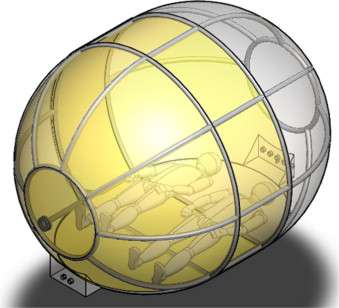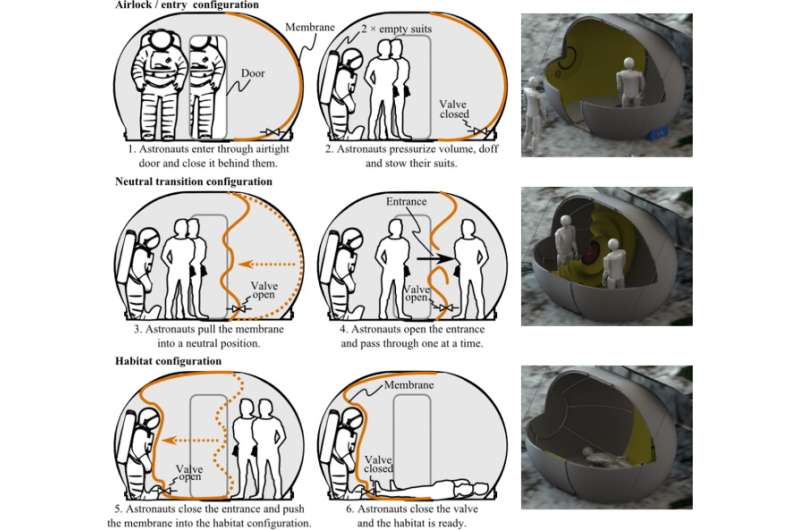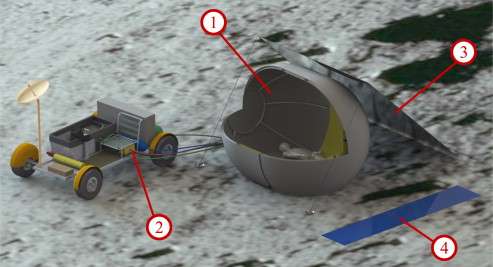June 16, 2015 weblog
Habitat is designed to provide stay on the moon, sleeps two

(Phys.org)—People have felt the excitement of seeing their courageous space heroes embark from the Earth to the moon. Those same heroes went up because, beyond completing the journey, they hoped to—in one word— explore. That has been a problem, said Charles Q. Choi in Popular Science, who referred to the limitations in "hang time."
He wrote, "The Apollo program landed a dozen men there from 1969 to 1972, but they spent a total of only three days and six hours actually walking the surface. That's because they couldn't stray from their lunar lander and its life support."
Now a team of researchers have devised a way to extend a stay and extend the explorers' reach beyond the lunar lander. The answer is in packable, inflatable tents. The astronauts could stray from the lunar lander to spend more time on the actual surface of the moon. The team wrote that, "Instead of returning to base, the astronauts would then enter the habitat, doff their suits,and prepare for a second day of lunar exploration (eat,sleep,hygiene,etc.)."
Boing Boing said that the researchers designed a pill-shaped inflatable moon tent that sleeps two. The tent fills with oxygen. Their paper, which is available online, details their work, and is titled, "An overnight habitat for expanding lunar surface exploration," in Acta Astronautica.
The authors are from MIT (Department of Aeronautics and Astronautics) and from Brown (Department of Geological Sciences).

"The system is intended to enable two astronauts, exploring with an unpressurized rover, to remove their spacesuits for an 8-hr rest away from the lunar base and then conduct a second day of surface exploration before returning to base," they wrote.
They noted how lunar surface exploration systems will need to evolve from a system designed for short-term sorties to a system that can support longer durations. That goal is what they have in mind; they presented their conceptual design, they said, in the context of next-generation lunar exploration. The authors said their system will enable two astronauts to conduct a full day of lunar surface exploration, sleep and recover within the inflatable habitat at a location away from the lunar base and then conduct a second day of exploration before returning to the base.
As such, this is more than a sleeping tent; it is a sustaining habitat. As Boing Boing said, it is a system that protects explorers from the sun's rays and it helps to keep out moon dust from sleeping quarters.
Moon dust can be dangerous. Popular Science said it collects on an astronaut's suit. "The dust is electrostatically charged and sticks to everything, the way a rubbed balloon attracts lint. It is also dangerous, each grain similar to a shard of glass."
Choi in Popular Science said that lunar dust can cause skin and eye irritation and corrosion. When inhaled, it can possibly cause lower-airway issues.

Choi said the team came up with the idea of a "flexible divider inside the pod that can be moved to cordon off the area where astronauts remove their suits from where they sleep."
The proposed system has the potential to double the reachable distance from the lunar base, increasing the reachable area by a factor of four.
Choi in Popular Science summarized the components in their design: It is made up of "an inflatable pod that sleeps two; a reflective shield to prevent the sun's rays from roasting explorers; life support systems on the rover that will supply oxygen, water and food, maintain the habitat's temperature, scrub out carbon dioxide, and remove excess humidity; and a flexible roll-out solar array to supply the shelter's power and recharge the rover's batteries."
MIT's Samuel Schreiner, one of the study's authors, said in Popular Science that the system, when packed, takes up about half as much space as an average refrigerator.
More information: An overnight habitat for expanding lunar surface exploration, Acta Astronautica, Volume 112, July–August 2015, Pages 158–170. DOI: 10.1016/j.actaastro.2015.03.012
Abstract
This paper presents the conceptual design and analysis of a system intended to increase the range, scientific capability, and safety of manned lunar surface exploration, requiring only a modest increase in capability over the Apollo mission designs. The system is intended to enable two astronauts, exploring with an unpressurized rover, to remove their space suits for an 8-h rest away from the lunar base and then conduct a second day of surface exploration before returning to base. This system is composed of an Environmental Control and Life Support System on the rover, an inflatable habitat, a solar shield and a solar power array. The proposed system doubles the distance reachable from the lunar base, thus increasing the area available for science and exploration by a factor of four. In addition to increasing mission capability, the proposed system also increases fault tolerance with an emergency inflatable structure and additional consumables to mitigate a wide range of suit or rover failures. The mass, volume, and power analyses of each subsystem are integrated to generate a total system mass of 124 kg and a volume of 594 L, both of which can be accommodated on the Apollo Lunar Roving Vehicle with minor improvements.
Journal information: Acta Astronautica
© 2015 Phys.org



















